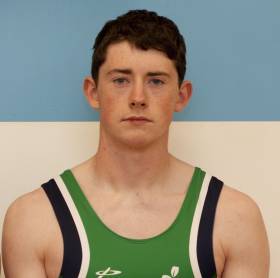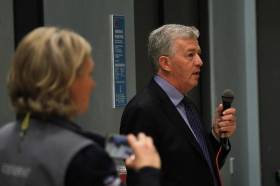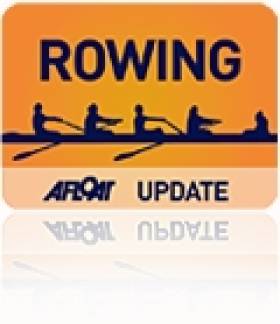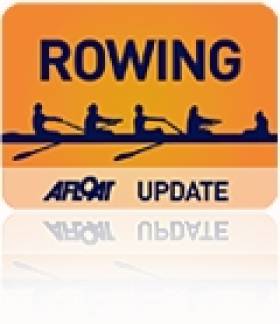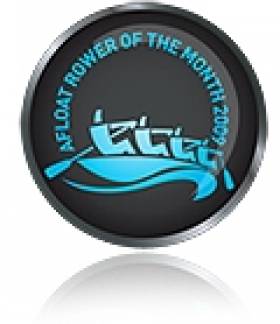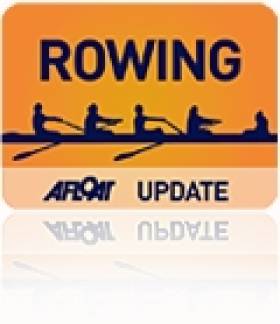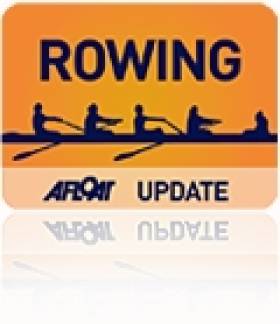Displaying items by tag: NUIG
NUIG Best Eight at Sun-Blessed Lough Rynn Regatta
#Rowing: NUIG won a two-boat battle with Commercial in the men’s senior eights final at the inaugural Lough Rynn Regatta in Leitrim today. The young crew had just under two lengths to spare. Daire Lynch of Clonmel and Ronan Byrne of Shandon won the men’s senior double – a notable victory for this junior crew as they set out to prove their capacity to the Ireland selectors. Portora had an excellent day, with their club one eight being the best women’s crew. The regatta was a success and was run in spectacular conditions, with bright sunshine and calm water.
Lough Rynn Regatta, Saturday – Selected Results
Men
Eight - Senior: NUIG A. Intermediate: Portora. Jun 18A: Portora. Jun 16: Portora. Jun 15: St Joseph’s. Masters: Commercial/Sligo/Tribesmen. Mixed Invitational: Portora A.
Four – Senior: NUIG A. Jun 18A, coxed: Pres, Cork A. Jun 16, coxed: Portora. Invitational: Galway D204.
Pair – Senior: Commercial A. Inter: Portora. Jun 18A: Clonmel.
Sculling, Quadruple – Club One, coxed: Neptune. Nov: Neptune B. Jun 18A: Three Castles. Jun 16: Commercial. Jun 15: St Joseph’s.
Double – Senior: Clonmel/Shandon (D Lynch, R Byrne). Club One: Sligo. Jun 18A: Commercial. Jun 16: Col Iognaid.
Single – Senior: Garda (D Kelly). Inter: Athlone (P Munnelly). Masters: Commercial (D Crowley). Jun 18A: Commercial (Beggan). Jun 16: Col Iognaid (M Ryder).
Women
Eight – Club One: Portora. Jun 18A: Portora. Jun 16: Col Iognaid.
Four – Inter, coxed: Portora. Club One, coxed: Commercial B. Jun 18A: Galway RC.
Pair – Sen: Bann. Inter: Bann.
Sculling, Quadruple – Club One: Commercial. Nov: Neptune A. Jun 18A: Bann. Jun 16, coxed: Galway RC. Jun 15, coxed: Commercial A.
Double – Club One: Univ of Limerick A. Jun 18A: Bann. Jun 15: Commercial A.
Single – Sen: Three Castles (B Quinn). Inter: Garda (B Larsen). Jun 18A: Neptune (C Feerick). Jun 16: Col Iognaid (C Nic Dhonncha).
Shandon First and Second in Quadruples Final
#Rowing: Shandon impressed in the second set of finals at the Skibbereen Regatta at the National Rowing Centre. Their senior composite quadruple, with Athlone’s Patrick Munnelly, won the Division One A Final, holding off a Shandon junior quad. Lee won the women’s Division One quad. NUIG were well on top in the men’s coxed four, but the women’s race was a battle to the line, with Commercial just holding off UCD.
Skibbereen Regatta, National Rowing Centre, Cork, Saturday (selected results)
Men
Eight – Division Two – A Final: 1 Trinity A (novice) 6:18.4; 2 UCC (club two) 6:22.0; 4 Cork (jun 18B) 6:30.7. B Final: Shandon (jun 16) 6:33.9.
Four – Division One (coxed) – A Final: 1 NUIG (sen) 6:52.4, 2 Queen’s (club one) 6:56.1, 3 Trinity (club one) 6:56.9; 5 St Joseph’s A (jun 18A) 7:02.2. B Final: 1 UCC (inter) 6:58.4.
Pair – Division One – A Final: 1 Trinity (sen) 6:56.8, 2 Commercial A (sen) 7:00.0, 3 Commercial C (sen) 7:01.2; 5 UCC (inter) 7:11.3. B Final: 1 Trinity A (sen) 7:12.4; 4 Queen’s (club one) 7:27.1.
Sculling,
Quadruple – Division One – A Final: 1 Shandon/Athlone (sen)
6:15.0, 2 Shandon (jun 18A) 6:16.1, 3 Commercial (jun 18A) 6:22.7. B Final: 1 Skibbereen (inter) 6:39.5; 2 Queen’s (club one) 6:46.1.
Double – Div Two – A Final: 1 Carlow (jun 18B) 7:04.6; 2 Skibbereen (club two) 7:11.9. B Final: 2 Waterford (jun 16) 7:26.1.
Single – Div One – A Final: 1 Queen’s (P Doyle, sen) 7:18.2, 2 Clonmel (D Lynch; jun 18A) 7:18.5, 3 Queen’s (C Beck; lwt) 7:24.3; 4 Skibbereen (F McCarthy; inter) 7:26.4. B Final: 1 Garda (D Kelly; sen) 7:32.8; 5 UCC (D Synott; club one) 7:46.2. C Final: Portadown (S McKeown; sen) 7:25.0
Women
Eight – Div Two – A Final: 1 UCD (club two) 7:02.8; 3 Shandon (jun 18B); 5 Col Iognaid (jun 16). B Final: 4 Trinity A (nov) 7:44.2. Four – Division One (coxed) – A Final: Commercial (inter) 7:36.9, 2 UCD (sen) 7:37.5, 3 St Michael’s (inter) 7:46.8; 4 Queen’s (club one) 7:55.8. B Final: 1 NUIG (club one) 7:44.3.
Pair – Div One – A Final: 1 Cork (jun 18A) 7:55.47, 2 UCC (inter) 8:08.1, 3 Queen’s (inter) 8:14.8; 4 Trinity (club one) 8:21.6.
Sculling,
Quadruple – Division One – A Final: 1 Lee (jun 18A) 7:20.4, 2 Skibbereen (jun 18A) 7:25.1, 3 Fermoy (club one) 7:27.3; 4 UCC (inter) 7:30.2, 5 Belfast BC, Queen’s, Fermoy (sen) 7:30.9. B Final: Commercial (jun 18A) 7:47.6. Div Two – A Final: 1 Cork A (jun 18B) 7:46.4; 2 Workman’s (jun 16) 7:49.0; 6 St Michael’s (club two) 8:15.6. C Final: 5 Univ of Limerick (nov) 8:56.2.
Double – Div Two – A Final: 1 Carlow (club two) 8:02.4; 2 Carlow (jun 18B) 8:08.6; 3 Workman’s (jun 16) 8:11.0.
Single – Div One – A Final: 1 Killorglin (M Dukarska; sen) 7:55.4, 2 Skibbereen (D Walsh; sen) 7:58.9, 3 Skibbereen (S Dolan; sen) 8:05.8; 4 Skibbereen (E Hegarty; jun 18A) 8:12.6, 5 UCD (A Crowley; inter) 8:20.4. B Final: 1 Skibbereen (O Hayes; lightweight) 8:27.7; 4 Belfast BC (O Blundell; club one) 8:32.8. C Final: 1 Garda (B Larsen; inter) 8:36.81.
Rowing Blitz a Big Success in Galway
Over 140 secondary school students and 18 volunteers from Galway City attended the first Connacht #Blitzit2016 Challenge which took place at NUI Galway. The challenge, a curriculum within the Get Going, Get Rowing programme, saw students competing in a series of physical challenges, culminating in an indoor rowing challenge covering a total of 90,000m to symbolise the distance from Galway to Rio.
The Get Going, Get Rowing programme in Connacht gives secondary school pupils the opportunity to actively engage with a new sport on NUI Galway’s campus or within the students’ own schools. The programme is run by Rowing Ireland who received funding from The Irish Sports Council (ISC) Women in Sport initiative in 2014. In November 2014, Rowing Ireland joined forces with NUI Galway to to jointly fund the Get Going, Get Rowing programme in Connacht.
Mike Heskin, recently appointed Director of Sport and Physical Activity at NUI Galway, said: “NUI Galway, as one of the major rowing universities in Ireland, is delighted to be involved with Rowing Ireland in this very exciting project. As 2016 will be a very exciting year for rowing, with Ireland being represented by two crews in Rio, I hope events such as this will inspire those taking part to have aspirations to be the best they can be and possibly compete in an Olympic Games in the future. ”
The NUI Galway Schools’ Challenge commenced with a flurry of activity where groups of 25 students in five separate groups rotated from one activity to the next at high speed. They finished the challenge by completing 40 minutes of racing on indoor rowing machines. This was then followed by a series of talks on nutrition, mindful movements and the positive effects of physical activity on academic results.
The Get Going, Get Rowing programme also offers schools a training course, TrY rowing, to Transition Year students and provides coaching sessions in these schools upon completion of the course. To date, over 50 TrY students have become coaches and the programme provided indoor rowing machines (ergometers) to schools who have completed the TrY rowing and who have fully engaged with the programme.
# Sam McKeown of Portadown set a time of six minutes 4.7 seconds, the fastest at the Ulster Indoor Championships at Queen’s University, and a personal best for the under-23 competitor. In Limerick, Richard O’Hagan won the open and 500 metres categories at the Irish Provinces Indoor Championships, with times of 6:09.4 and 1:19.6. NUIG had a good day, and Liam Keane (also under-23) was the fastest lightweight.
Junior 18 competitor Ronan Byrne of Shandon set a new record for the 2,000 metres of 6:16.9, while fellow junior Eoghan Walls-Tuite set an excellent time of one minute 22.3 seconds for 500 metres.
Monika Dukarska of Killorglin was the fastest woman, and Siobhán McCrohan the fastest lightweight woman.
Irish Provinces Indoor Rowing Championships, University of Limerick (Selected Results; 2000 metres unless stated)
Men
Open – 1 R O’Hagan 6:09.4, 2 F Crowley 6:24.9, 3 A Prendergast 6:25.5. 30-39: G Conway 6:19.7. Open 500: R O’Hagan 1:19.6.
Under-23: A Kinneen 6:20.2. Junior 18: R Byrne 6:16.9, 500: E Walls-Tuite 1:22.3.
Jun 16: J Keating 6:33.8, 500: J McCarthy 1:29.8.
Jun 15 (1,000): R MacCurtain 3:23.6.
Freshers (1,000); G Barlow 3:05.2.
40-49: N Carey 6:24.3, 500: Carey 1:23.9. 50-59: O Short 6:46.9, 500: Short 1:29.4. 60-69: P Victory 6:57.6, 500 (60+): P Victory 1:32.6.
Lightweight – Open: D O’Connor 6:33.5, 500: L Keane 1:28.9.
Lightweight Under-23: L Keane 6:25.0, 500: Keane 1:28.9. Lightweight 40-49: J Doyle 6:29.1.
Women
Open – 1 M Dukarska 7:02.7, 2 A O’Sullivan 7:19.0, 3 M Piggott 7:34.7. 500: M Dukarska 1:33.6.
Under-23: S Bounane 7:18.7. Junior 18: M Cremin 7:23.3.
500: M Cremin 1:38.8.
Jun 16: A O’Farrell 7:32.7, 500: L Turner 1:44.1.
Jun 15: (1,000): A Doyle 3:50.6, 500: J Crowley 1:41.1
Freshers (1,000): B Chase 3:43.2.
30-39: S Kennelly 7:24.9. 40-49: P O’Brien 7:51.8, 500: R Ware 1:43.3. 50-59: M Lawlor 8:11.2, 500: Lawlor 1:55.9.
Lightweight – Open: S McCrohan 7:14.7, 500: K Wilkie 1:44.4.
Lightweight Under-23: E McGiff 7:49.2.
Lightweight 30-39: C Conway 7:48.3.
LTA – S McLoughlin 3:51.1, 500: McLoughlin 1:51.0.
Ulster Indoor Rowing Championships, Queen’s University, Saturday (Selected Results, 2,000 metres unless stated). Includes BUCS: British University Championships.
Men
Open: S McKeown 6:04.7, 2 M Christie 6:25.9. BUCS Open: 1 T Oliver 6:10.6, 2 P Doyle 6:26.9, 3 R Urquart 6:34.7. BUCS Lightweight: C Beck 6:31.2.
Under-23 Lightweight: A Laivinas 6:50.3.
Under-18: D Mitchell 6:26.0. Under-16: A Christie 6:39.3. Under-15: A Graham (1,000m) 3:32.7.
BUCS Beginners (1,000): J Lobinger 3:11.4.
Women
Open: R Maguire 7:15.4. BUCS Open: Maguire 7:15.4. BUCS Open Lightweight: R Brown 7:46.7.
Under-23: K Shirlow 7:28.3.
Under-18: F Chestnutt 7:31.0.
Under-16: L McIntyre 7:46.2. Under-15 (1,000m): A Hall 3:54.6. 30+ (1,000m): L Kerr 3:20.9.
BUCS Beginners (1,000m): A Druijff 3:45.8.
Skibbereen and Tribesmen Best of Irish Lightweights
#Rowing: Justin Ryan and Siobhan McCrohan took the lightweight single sculls titles at the Irish Rowing Championships today. The Skibbereen man and Tribesmen woman were commanding winners. McCrohan had already won the senior singles title, while Ryan was taking his second consecutive lightweight title at the National Rowing Centre. Last year he represented UCC.
Two crews won by taking early command of their races. Colm Hennessy and Ronan Byrne in the Shandon junior double and the Commercial intermediate pair of Colm Dowling and Neil Gahan gauged the tailwind well and used it to back up their good starts.
NUIG also won the women’s intermediate coxed four well, and Bann’s Hannah Scott and Katie Shirlow, added the junior pair to their junior fours crown.
Queen’s took the club coxed four, having already won the club eight. They held off UCD’s challenge in the closing stages.
Irish Rowing Championships, National Rowing Centre, Cork, Day Three (Selected results)
Men
Four – Club, coxed: 1 Queen’s 6:28.23, 2 UCD A 6:30.77, 3 NUIG A 6:36.48.
Pair – Intermediate: 1 Commercial A 6:47.94, 2 Skibbereen 6:55.20, 3 Portora 7:00.19.
Sculling, Double – Junior: 1 Shandon 6:40.27, 2 Castleconnell A 6:50.48, 3 Cork BC B 6:55.56.
Lightweight Single: 1 Skibbereen (J Ryan) 7:09.17, 2 Skibbereen (McCarthy) 7:12.63, 3 St Michael’s (D O’Connor) 7:15.40.
Women
Four – Intermediate, coxed: 1 NUIG 7:09.66, 2 Commercial 7:18.28, 3 Shannon 7:23.16.
Pair – Junior: 1 Bann 7:42.60, 2 Portora 7:47.30, 3 Lee 7:51.35.
Sculling, Single – Lightweight: 1 Tribesmen (S McCrohan) 7:46.48, 2 Commercial (Sarah Dolan) 7:50.22, 3 Skibbereen (O Hayes) 8:00.39.
#Rowing: UCC’s Andy Harrington and David O’Leary won the men’s senior pairs title at the Irish Rowing Championships this morning. The young crew flew away from their opponents in the third quarter and won well from NUIG.
Trinity had a fine win in the men’s intermediate eights, finishing well under pressure from UCD, while Portora’s win in the men’s junior coxed four was even closer. They were caught by St Joseph’s of Galway coming up to the line, but pushed again and won – by .16 of a second.
The women’s races were won by clearer margins. Dervla Forde took the junior single sculls, Skibbereen’s Orla Hayes and Aoife Casey the intermediate double and Commercial the novice eights, all in impressive fashion.
Cathal Merz also led down the course to win the men’s club single sculls.
Irish Rowing Championships, National Rowing Centre, Cork (Day Two, Selected Results)
Men
Eight – Intermediate: 1 Trinity 5:46.51, 2 UCD A 5:49.27, 3 Queen’s 6:08.61.
Four – Junior, coxed: 1 Portora 6:36.84, 2 St Joseph’s 6:37.0, 3 Athlunkard 6:45.18.
Pair – Senior: 1 UCC 7:03.18, 2 NUIG 7:10.16, 3 Carlow 7:12.51.
Sculling, Single – Club: 1 Shandon (C Merz) 7:42.94, 2 Clonmel (D Lynch) 7:44.96, 3 Lee (D Larkin) 7:45.94.
Women
Eight – Novice: 1 Commercial 6:59.55, 2 Queen’s 7:13.67, 3 Trinity 7:13.67.
Sculling, Double – Intermediate: 1 Skibbereen 7:36.62, 2 St Michael’s 7:45.87, 3 Belfast BC 7:48.80.
Single – Junior: 1 Cork (D Forde) 8:07.98, 2 Skibbereen (E Hegarty) 8:18.01, 3 Offaly (A Mooney) 8:21.91.
NUIG/Grainne Mhaol and Keohane Win at Irish Championships
#Rowing: NUIG/Grainne Mhaol won the men’s senior four on the first day of the Irish Rowing Championships today. Alan Martin’s crew overtook long-time leaders Commercial and beat them by over two seconds at the National Rowing Centre. It was Martin’s 10th senior fours crown and his 21st championship.
John Keohane roared with relief after taking his fourth consecutive senior single sculls championship. He was tested coming up to the finish by Erik Rowan, but had built up a big lead and was able to win by over a second. Old Collegians won the men’s senior double by a big margin.
The women’s senior four went to Trinity and the senior pair to UCC. The men’s junior eight saw Portora tested by St Joseph’s of Galway, but the Enniskillen club prevailed. Patrick Munnelly of Athlone won the junior single.
Bann’s crew of Rebecca Meenagh, Erin Barry, Hannah Scott and Katie Shirlow won the women’s junior four by .36 of a second from fast-finishing Skibbereen.
Irish Rowing Championships, National Rowing Centre, Cork (Selected Results)
Men
Eight – Club: 1 Queen’s 6:03.62, 2 Cork BC 6:03.93, 3 UCD 6:08.53. Junior: 1 Portora 6:00.69, 2 St Joseph’s 6:03.82, 3 Bann 6:13.00.
Four – Senior: 1 NUIG/Grainne Mhaol 6:11.63, 2 Commercial 6:13.97, 3 UCC 6:21.35. Inter, coxed: 1 NUIG 6:41.64, 2 St Michael’s 6:44.03, 3 UCD 6:49.83.
Sculling, Quadruple – Novice, coxed: Commercial 7:38.90.
Double – Senior: 1 Old Collegians 6:59.99, 2 Garda 7:12.07, 3 St Michael’s 7:48.13.
Single – Senior: 1 Lee Valley (J Keohane) 7:15.02, 2 Skibbereen (E Rowan) 7:16.08, 3 Skibbereen (J Ryan) 7:18.78. Junior: 1 Athone (P Munnelly) 7:32.18, 2 Shandon (R Byrne) 7:34.19, 3 Bann (D Mitchell) 7:36.09.
Women
Eight – Intermediate: 1 UCD 6:40.99, 2 NUIG 6:55.31, 3 Garda 7:00.87.
Four – Senior: 1 Trinity 7:13.81, 2 UCC/Cork BC 7:17.54, 3 Skibbereen 7:45.50. Club, coxed: 1 NUIG 7:27.35, 2 Cork BC 7:37.45, 3 Queen’s A 7:43.13. Junior: 1 Bann 7:05.57, 2 Skibbereen 7:05.93, 3 St Michael’s 6:21.65.
Pair – Senior: 1 UCC 7:37.44, 2 Trinity 7:48.40, 3 Shannon A 7:52.21. Inter: 1 Shannon 8:00.04, 2 Cork BC 8:10.49, 3 UCC 8:12.14.
Sculling, Quadruple – Novice, coxed: 1 Fermoy 7:48.72, 2 NUIG 8:05.59, 3 Castleconnell 8:14.48.
Double – Junior: 1 Skibbereen 7:37.95, 2 Bann 7:44.66, 3 Lee A 7:51.45.
Trinity Senior Eight are Afloat Rowers of the Month
#ROWING: The Afloat Rowers of the Month for June are Trinity’s men’s senior eight. The Dublin University Boat Club crew had a convincing win in the Division One final at Cork Regatta, outpacing UCD and NUIG/Gráinne Mhaol. They crew took the Leander trophy, one of the most impressive prizes on offer in Irish sport. Well done to: Gearóid Mahon, Ian Hurley, John Magan, Michael Corcoran, Patrick Moreau, Mark Kelly, Liam Hawkes, David Butler and cox Cian Flynn.
Rower of the Month awards: The judging panel is made up of Liam Gorman, rowing correspondent of The Irish Times and David O'Brien, Editor of Afloat magazine. Monthly awards for achievements during the year will appear on afloat.ie and the overall national award will be presented to the person or crew who, in the judges' opinion, achieved the most notable results in, or made the most significant contribution to rowing during 2015. Keep a monthly eye on progress and watch our 2015 champions list grow.
Trinity Eight In Command at Cork Regatta
#ROWING: Trinity won the men’s eights impressively at the Cork Regatta at the National Rowing Centre today. The college crew took an early lead and extended it to a length at 500 metres. The chasing UCD and NUIG/Grainne Mhaol crews looked never likely to catch Trinity from that point on. The winning margin was over five seconds, with UCD taking second. NUIG’s intermediate crew won the women’s eights by an even bigger margin of over seven seconds from Skibbereen’s junior 18A eight.
Cork Regatta, National Rowing Centre (Selected Results)
Sunday
Men
Eight – Div One – A Final: 1 Trinity (senior) 5:40.667, 2 UCD (intermediate) 5:45.957, 3 NUIG/Grainne Mhaol 5:46.533; 4 Queen’s (Club One) 5:54.94; 5 St Joseph’s (jun 18A) 6:02.257. B Final: UCD (Club One) 6:01.593. C Final: Trinity (Club One) 6:28.997.
Four – Div One – A Final: 1 NUIG/Grainne Mhaol (sen) 6:07.807, 2 UCC A 6:10.83, 3 Carlow (sen) 6:15.543. Four, coxed – Div Two – A Final: Skibbereen (Club Two) 6:43.837. B Final: Trinity (Club Two) 7:04.517; 3 Col Iognaid (jun 16) 7:06.357.
Sculling
Quadruple – Div Two – A Final: Cork (jun 16) 6:45.45; 6 Lee (Club Two) 7:03.56. B Final: Workmans (jun 16) 6:59.8; 4 Workman’s (jun 18B) 7:06.817. C Final: Carlow (jun 16) 7:05.697.
Double – Div One – A Final: 1 Old Collegians (D Neale, S Jacob; sen) 6:29.50, 2 Portadown/Skibbereen (sen) 6:34.43, 3 Shandon (jun 18A) 6:44.873. B Final: Waterford (inter) 6:46.473. C Final: Lee (inter) 6:48.227; 4 Methody (Club One) 7:10.627.
Single – Div Two – A Final: Belfast BC (A Murray; jun 18B) 7:35.483, 2 Cappoquin (Aherne; club two) 7:5.052; 4 Lee (Jackson, jun 16) 7:49.427. B Final: Clonmel (Dundon; jun 16) 7:49.347. C Final: St Michael’s (O’Byrne; jun 16) 7:48.40.
Women
Eight – Div One – A Final: 1 NUIG (inter) 6:43.177, 2 Skibbereen (jun 18A) 6:50.87, Commercial (inter) 6:57.593. Four – Div One – A Final: 1 Skibbereen (jun 18A) 7:08.330, 2 Shannon (sen) 7:12.137, 3 Skibbereen (sen) 7:27.62. Div Two, coxed – A Final: Queen’s A (Club Two) 7:27.26; 6 St Michael’s (jun 16) 8:32.17.
Sculling
Double – Div One – A Final: 1 Skibbereen (A Casey, E Hegarty; jun 18A) 7:28.957, 2 Lee (jun 18A) 7:33.43, 3 St Michael’s (inter) 7:43.430. B Final: Belfast BC A (inter) 7:39.570.
Single – Div Two – A Final: Lee (Cremin; Club Two) 8:16.437; Workman’s (Burns; jun 16) 8:32.55; 6 Shandon (jun 18B) 8:59.37. B Final: Cork (jun 16) 8:52.337. C Final: Lee Valley (jun 16) 8:56.26.
NUIG/Grainne Mhaol Four See Off Strong UCC Challenge
#ROWING: UCC gave them a good race, but NUIG/Grainne Mhaol moved away in the closing stages to prove themselves the top men’s four at Cork Regatta. The experience of Sean Jacob and Dave Neale also told in the men’s double scull, with the Ireland under-23 double of Sam McKeown and Andrew Griffin had to give way to the Old Collegians men. The women’s four and double went to young Skibbereen crews: Aoife Casey and Emily Hegarty, who are both 16, were part of the winning four and then switched into the double and won again.
Cork Regatta, National Rowing Centre (Selected Results)
Sunday
Men
Four – Div One – A Final: 1 NUIG/Grainne Mhaol (sen) 6:07.807, 2 UCC A 6:10.83, 3 Carlow (sen) 6:15.543. Four, coxed – Div Two – A Final: Skibbereen (Club Two) 6:43.837. B Final: Trinity (Club Two) 7:04.517; 3 Col Iognaid (jun 16) 7:06.357.
Sculling
Double – Div One – A Final: 1 Old Collegians (D Neale, S Jacob; sen) 6:29.50, 2 Portadown/Skibbereen (sen) 6:34.43, 3 Shandon (jun 18A) 6:44.873. B Final: Waterford (inter) 6:46.473. C Final: Lee (inter) 6:48.227; 4 Methody (Club One) 7:10.627.
Single – Div Two – A Final: Belfast BC (A Murray; jun 18B) 7:35.483, 2 Cappoquin (Aherne; club two) 7:5.052; 4 Lee (Jackson, jun 16) 7:49.427. B Final: Clonmel (Dundon; jun 16) 7:49.347. C Final: St Michael’s (O’Byrne; jun 16) 7:48.40.
Women
Four – Div One – A Final: 1 Skibbereen (jun 18A) 7:08.330, 2 Shannon (sen) 7:12.137, 3 Skibbereen (sen) 7:27.62.
Sculling
Double – Div One – A Final: 1 Skibbereen (A Casey, E Hegarty; jun 18A) 7:28.957, 2 Lee (jun 18A) 7:33.43, 3 St Michael’s (inter) 7:43.430. B Final: Belfast BC A (inter) 7:39.570.



























